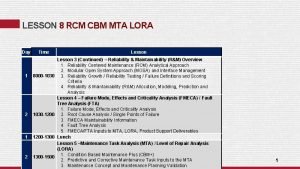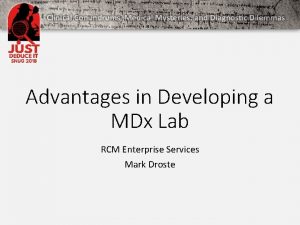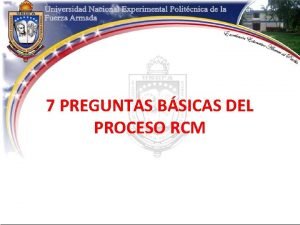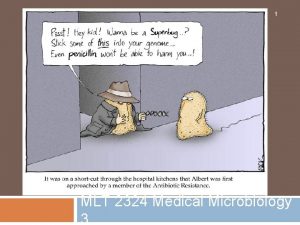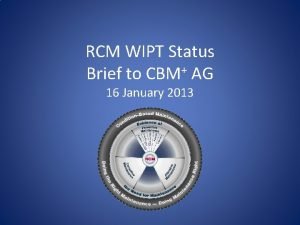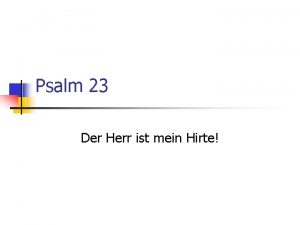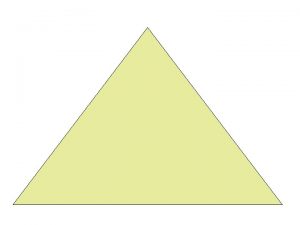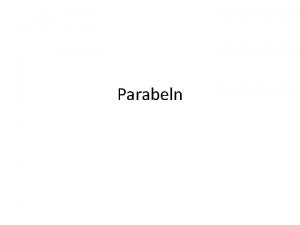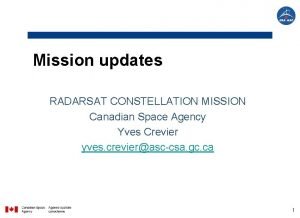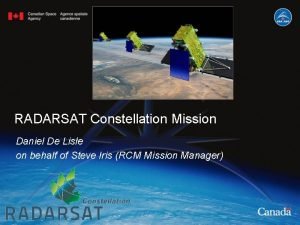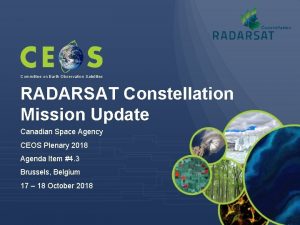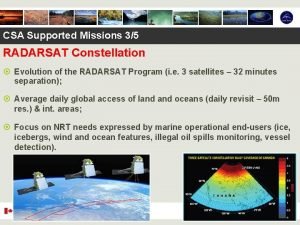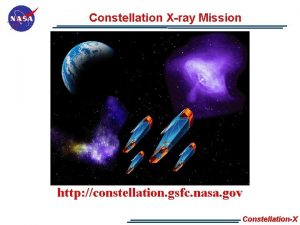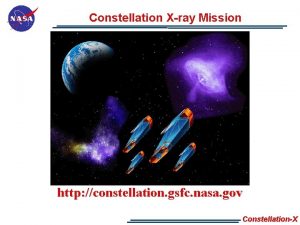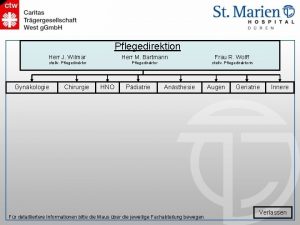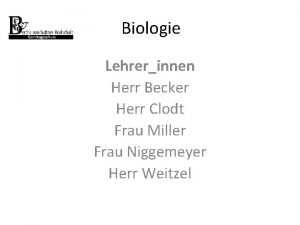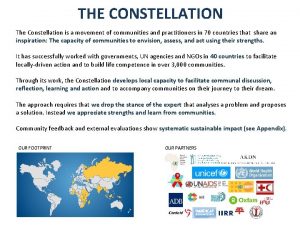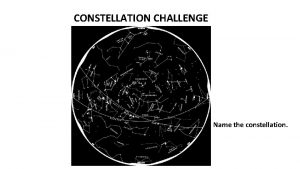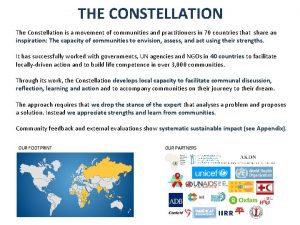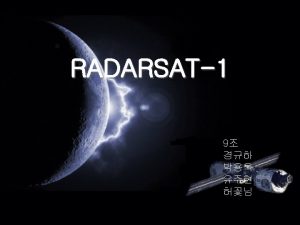RADARSAT Constellation Mission RCM DANIEL HERR Canadian Space
















![References [1] A. Fourmault, C. Grenier, P. Allan, and G. Richardson, "RCM SAR antenna References [1] A. Fourmault, C. Grenier, P. Allan, and G. Richardson, "RCM SAR antenna](https://slidetodoc.com/presentation_image_h2/bcffdea894b93da31277312457bae99c/image-17.jpg)




- Slides: 21

RADARSAT Constellation Mission (RCM) DANIEL HERR © Canadian Space Agenc

Overview Successor to RADARSAT-2 program ◦ Designed to provide continuity for data users of RADARSAT-2 ◦ Reliability and iterative improvements Canada's new generation of Earth observation satellites ◦ Operated by Canadian Space Agency ◦ Three identical satellites ◦ Launched on June 12, 2019 The trio of satellites provide more frequent revisit rates demanded by data users © Canadian Space Agenc

RCM Satellite Data Products: ◦ Maritime surveillance (ice, surface wind, oil pollution and ship monitoring); ◦ Disaster management (mitigation, warning, response and recovery); and ◦ Ecosystem monitoring (agriculture, wetlands, forestry and coastal change monitoring). © Canadian Space Agenc

RADARSAT-1 RADARSAT-2 RADARSAT Constellation Active antenna C-Band Centre frequency 5. 3 GHz 5. 405 GHz Bandwidth 30 MHz 100 MHz Polarization HH HH, VV, HV, VH, Compact Polarimetry Polarization isolation > 20 d. B > 25 d. B > 30 d. B Aperture length 15 m 6. 75 m Aperture width 1. 5 m 1. 37 m 1. 38 m Mass 679 kg 750 kg 400 kg approximate Deployment mechanism Extendable support structure (ESS) ESS Simple strut deployment with a kinematically decoupled internal support structure (https: //www. asc-csa. gc. ca/)

RADARSAT-1 RADARSAT-2 RADARSAT Constellation Owner Government of Canada MDA Government of Canada Launch November 4, 1995 December 14, 2007 June 12, 2019 Status Inactive Active High resolution 8 m× 8 m (stripmap mode) 1 m× 3 m (spotlight mode) Total mass at launch 2, 750 kg 2, 200 kg 1, 400 kg Mission life 5 years 7 years (each satellite) SAR antenna dimensions 15 m × 1. 5 m 6. 75 m × 1. 38 m Solar arrays (each) 2. 21 m × 1. 32 m 3. 73 m × 1. 8 m 2. 2 m × 1. 7 m main power (one panel vs. two for RADARSAT-1 and ADARSAT-2) 0. 5 m × 1. 6 m (keep-alive power) Bus 3. 55 m × 2. 46 m 3. 7 m × 1. 36 m 3. 6 m × 1. 1 m Look direction Right-looking • Routine left- and rightlooking operation • Increased re-visit time for improved monitoring efficiencies • Right-looking • Multiple satellites will eliminate the need for left- and right-looking to increase revisit (https: //www. asc-csa. gc. ca/)

RCM Operating Modes SAR design trade-space between swath width and high azimuth resolution Supports Strip. Map, Scan. SAR, and Spotlight modes Secondary payload of Automatic Identification System (AIS) for ships, that is used independently or in conjunction with the SAR. (Fourmault, 2010)

Antennas C-band active phased array ◦ Composed of 2 SAR Antenna Panel Assemblies (SAPA). ◦ Phase (TX & RX) and amplitude (RX) control Each panel contains 96 subarrays ◦ 3 columns with 32 rows each ◦ Each subarray consists of 24 dual polarization patch radiating elements ◦ That’s 4608 patches per satellite! Array Dimensions 6. 75 x 1. 38 m ◦ ◦ Element spacing ~0. 8445 λ x ~0. 776969 λ Sub-array ~20. 268750 λ in Length Range resolution 1. 5 m Azimuth resolution ~3. 375 m © Canadian Space Agenc

RF Distribution Network (Fourmault, 2010)

TRM Modules 2013 -01 -04 - A transmit/receive module (TRM). Each RCM satellite has 192 TRMs. Each TMR provide • Transmit power amplification to the radar pulse generated by the Central Electronics (CE) • First stage Receive amplifier • Phase and amplitude control to produce the desired beam shapes. © Canadian Space Agency

TRM Modules 2015 -08 -06 - A view of the back of a synthetic aperture radar (SAR) panel. (Credit: Canadian Space Agency) 2015 -02 -13 - Two of the three columns of transmit/receive modules (TRMs) that make up the synthetic aperture radar (SAR) panel. ◦ Each RCM satellite has two SAR panels, each comprised of three electrical columns. ◦ Each column contains 32 TRMs. (Credit: Canadian Space Agency) © Canadian Space Agenc

SAR Antenna Panel 2015 -08 -06 - The radiating face of a synthetic aperture radar (SAR) panel. (Credit: Canadian Space Agency) © Canadian Space Agenc

SAR Panel Assembly 2014 -07 -07 - One of the RCM's synthetic aperture radar (SAR) panels is assembled to test its fit before permanently attaching. (Credit: Canadian Space Agency) © Canadian Space Agenc

Central Electronics 2015 -08 -06 - The two central electronic units of the payload responsible for generating and processing radio frequency signals for the synthetic aperture radar (SAR) antenna. (Credit: Canadian Space Agency) © Canadian Space Agenc

Rocket Payload 2019 -05 -22 - The three RADARSAT Constellation Mission (RCM) satellites are being integrated into the rocket fairing that will bring them to space. (Credits: Canadian Space Agency, MDA, a Maxar company) © Canadian Space Agenc

Rocket Payload 2019 -05 -22 - The three RADARSAT Constellation Mission (RCM) satellites are being integrated into the rocket fairing that will bring them to space. (Credits: Canadian Space Agency, MDA, a Maxar company) © Canadian Space Agenc

© Canadian Space Agenc
![References 1 A Fourmault C Grenier P Allan and G Richardson RCM SAR antenna References [1] A. Fourmault, C. Grenier, P. Allan, and G. Richardson, "RCM SAR antenna](https://slidetodoc.com/presentation_image_h2/bcffdea894b93da31277312457bae99c/image-17.jpg)
References [1] A. Fourmault, C. Grenier, P. Allan, and G. Richardson, "RCM SAR antenna capabilities, " in 2010 14 th International Symposium on Antenna Technology and Applied Electromagnetics & the American Electromagnetics Conference, 5 -8 July 2010, pp. 1 -4, doi: 10. 1109/ANTEM. 2010. 5552515. [2] J. Uher, "Comparison of RADARSAT-1 and RADARSAT-2 SAR antenna design and capabilities, " in 2002 9 th International Symposium on Antenna Technology and Applied Electromagnetics, 31 July-2 Aug. 2002, pp. 1 -4. Content from https: //www. asc-csa. gc. ca/eng/satellites/radarsat Images from https: //www. asc-csa. gc. ca/eng/multimedia/search

Extra Content

Antenna Beam Steering (Fourmault, 2010)

Antenna Beam Steering (Fourmault, 2010)

Polarization Modes (Fourmault, 2010)
 Herr du bist mein leben
Herr du bist mein leben Constellation space suit
Constellation space suit Canadian blood services mission statement
Canadian blood services mission statement Rcm statement writing
Rcm statement writing Mta
Mta Labrcm
Labrcm Rcm tcth
Rcm tcth 7 preguntas del rcm
7 preguntas del rcm Rcm microbiology
Rcm microbiology Rcm
Rcm Rcm status
Rcm status The boy in the striped pajamas chapter 17 summary
The boy in the striped pajamas chapter 17 summary Psalm 24 der herr ist mein hirte
Psalm 24 der herr ist mein hirte Psalm 139 1-2
Psalm 139 1-2 Brecht parabeln
Brecht parabeln Sehr geehrte frau dr.
Sehr geehrte frau dr. Ich werde dich nicht verlassen bibel
Ich werde dich nicht verlassen bibel Akkusativ pronomen deutsch
Akkusativ pronomen deutsch Herr dr. medic. (im tem.) adrian balint
Herr dr. medic. (im tem.) adrian balint Eines morgens ist der frühling da
Eines morgens ist der frühling da Herr winkler ich bin arbeitslos
Herr winkler ich bin arbeitslos Herr du erforschest mich und kennest mich
Herr du erforschest mich und kennest mich




